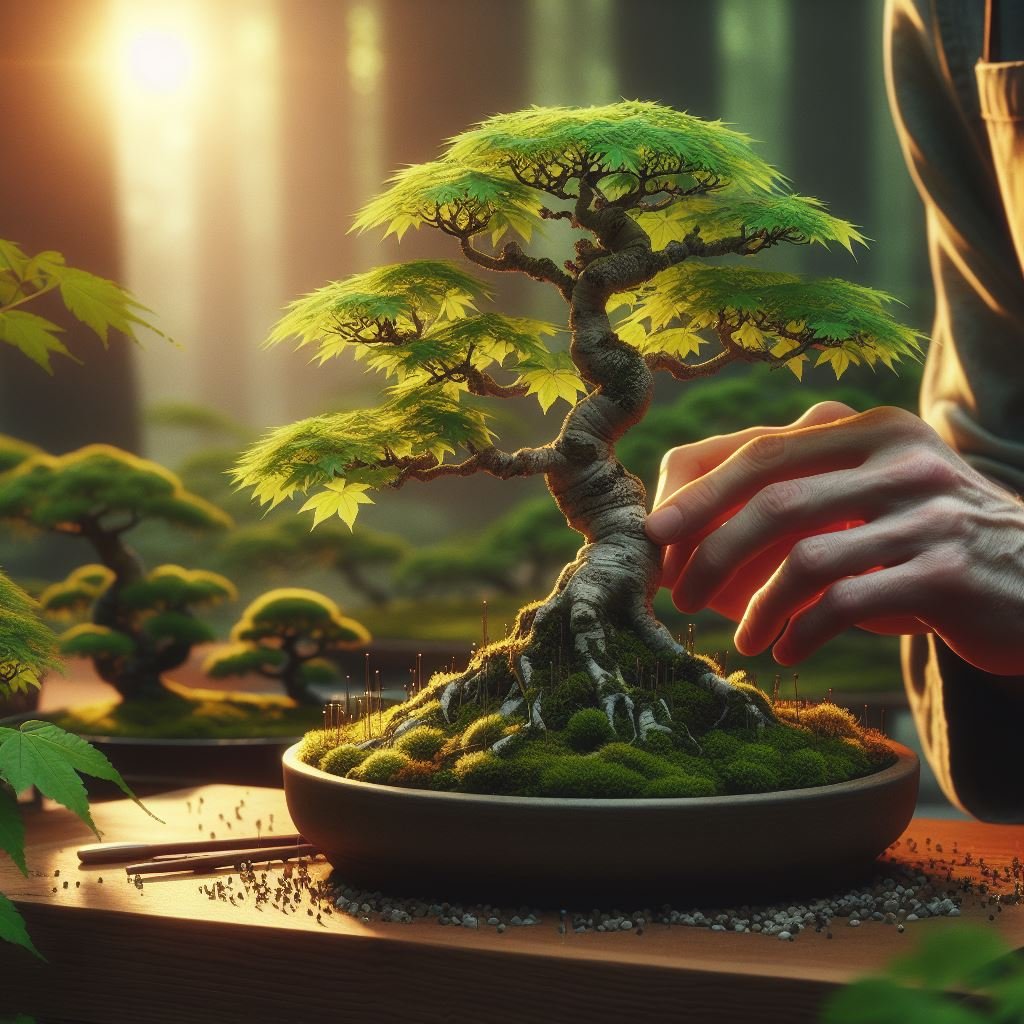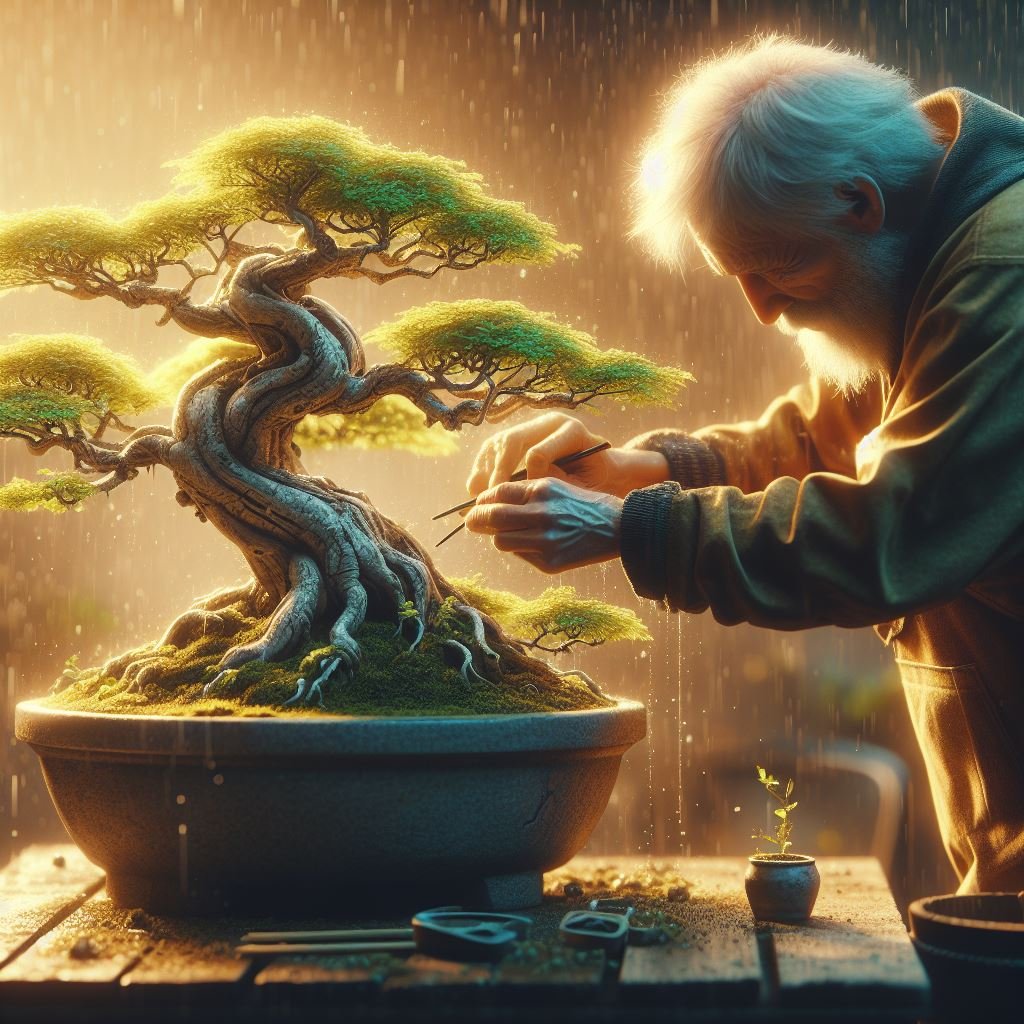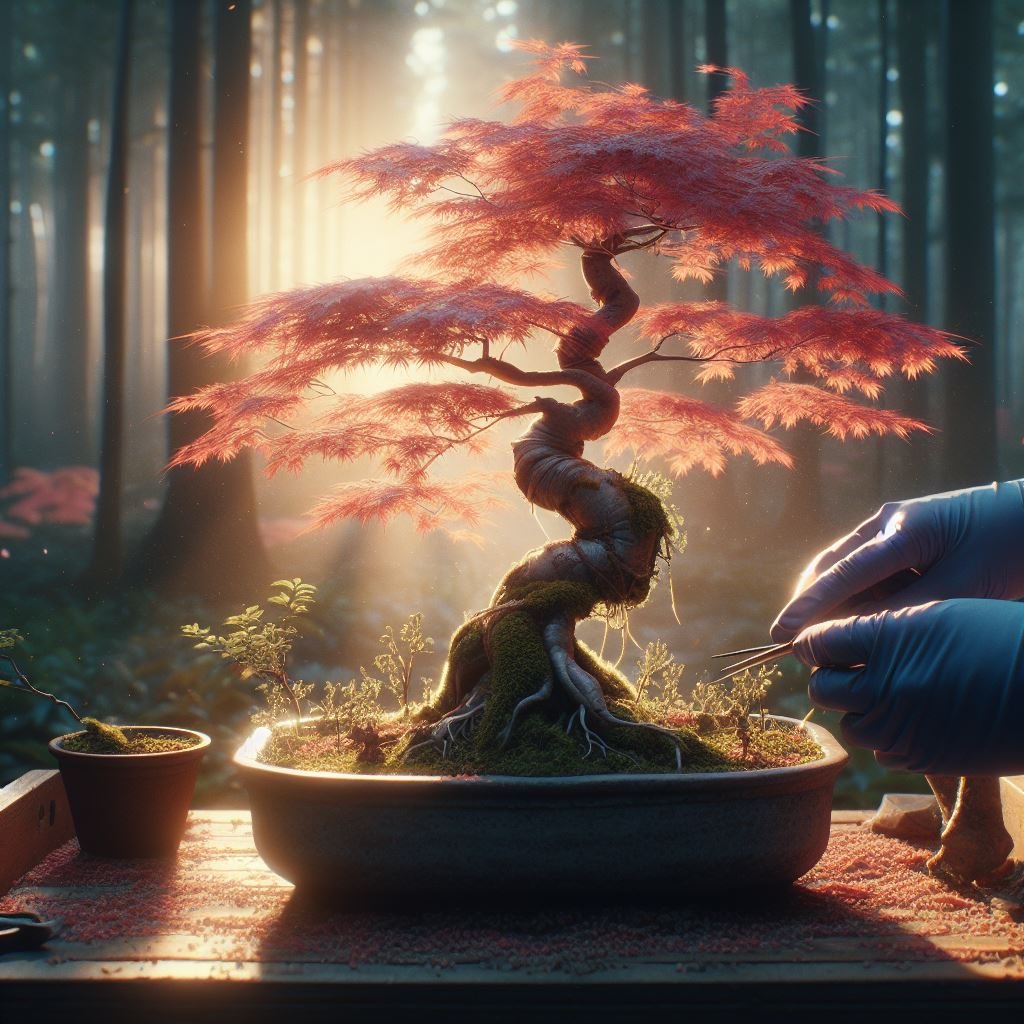The sugar maple, renowned for its spectacular fall colors, holds a special place in the hearts of many nature lovers. But did you know that this grand tree can also be miniaturized into a bonsai? Despite some challenges due to its leaf and internode size, the sugar maple bonsai is a sight to behold when properly cultivated. This guide will delve into the intricacies of growing and caring for a sugar maple bonsai, a beautiful representation of an American classic.
Introduction to Sugar Maple Bonsai
The Sugar Maple (Acer saccharum) is a deciduous tree that is indigenous to the hardwood forests of northeastern North America. It is best known for its vibrant, colorful foliage in the fall and as the primary source of maple syrup, one of nature’s sweetest gifts. Its leaves turn a range of colors from bright yellows to burnt oranges and fiery reds, creating a mesmerizing display of natural beauty.

As a bonsai tree, the sugar maple presents a unique allure. The miniature version of this majestic tree brings the splendor of fall right into your living room, balcony, or garden. The sugar maple bonsai offers the chance to observe up-close the tree’s seasonal changes, from the budding of new leaves in spring, the lush greenery of summer, the explosion of colors in autumn, and the bare, intricate branch patterns in winter.
Moreover, the sugar maple bonsai is not just visually appealing; it’s also a testament to the art of bonsai itself. Cultivating a sugar maple bonsai involves patience, care, and an understanding of the tree’s growth patterns. The journey from a sapling or cutting to a mature bonsai can be challenging, but the end result—a miniature echo of nature’s grandeur—is truly rewarding.
Understanding the Challenges
One of the main challenges of growing a Sugar Maple Bonsai is managing its leaf and internode size. In nature, the Sugar Maple is a large tree that can reach up to 115 feet (35 meters) in height with leaves that can grow up to 8 inches (20 cm) long. However, when cultivated as a bonsai, the tree must be miniaturized without losing its natural proportionality. This requires careful and strategic pruning to keep the leaves and internodes – the sections of stem between the leaves – small.
Leaf Size Issues
In bonsai cultivation, you want the leaves to be in scale with the size of the tree. Sugar Maples are known for their large leaves, which can pose a challenge when trying to create a proportional bonsai. One technique to reduce leaf size is called defoliation, which involves removing the leaves during the growing season. This encourages the tree to produce smaller leaves, better suited for a bonsai.
Internode Size Issues
The internode length on a Sugar Maple can also be quite long, which can make the tree look out of scale when miniaturized. Pruning is key here as well. By strategically cutting back the branches, you can control the internode length. Another method is to choose a specimen that naturally has shorter internodes.
The Stature of the Sugar Maple in Nature vs. as a Bonsai
In its natural environment, the Sugar Maple is a grand, towering tree with a broad, rounded crown. It’s known for its impressive fall color display and its sap, which is used to make maple syrup.
As a bonsai, the Sugar Maple retains its beautiful leaf coloration and overall tree shape, but on a much smaller scale. The aim is to create a miniature version that reflects the essence of the tree in its natural habitat. This requires patient and careful cultivation techniques, including pruning, wiring, watering, and repotting. Despite the challenges, a well-cared-for Sugar Maple Bonsai is a stunning representation of nature’s beauty, bringing the splendor of a forest into your own home or garden.
Steps to Cultivate Your Sugar Maple Bonsai

Selecting a Suitable Sapling or Cutting
The first step in creating a Sugar Maple Bonsai is to select a suitable sapling or cutting. Look for a young tree that has a strong, healthy appearance with no signs of disease or pest damage. If you are taking a cutting, choose a branch that is about the thickness of a pencil and cut it at an angle using a clean, sharp tool.
Planting and Initial Care for Your Bonsai
Once you have your sapling or cutting, it’s time to plant. Choose a shallow bonsai pot with good drainage. Fill the pot with a well-draining soil mix, typically a combination of akadama, pumice, and lava rock. Plant your sapling or cutting in the soil, ensuring that it’s planted firmly and upright.
After planting, water thoroughly and place the pot in a location that receives indirect sunlight. The sugar maple prefers a cooler climate, so avoid placing it in areas where it will be exposed to intense heat or direct afternoon sunlight.
During these initial stages, it’s crucial to maintain consistent watering. The soil should be kept slightly moist, but not waterlogged. Overwatering can lead to root rot, which can be fatal to your bonsai.
Techniques to Manage Leaf Size
As mentioned earlier, one of the challenges of growing a Sugar Maple Bonsai is managing its leaf size. Here are a few techniques to help control this:
- Defoliation: This involves removing the leaves during the growing season, which encourages the tree to produce smaller leaves. However, this technique should be used sparingly as it can stress the tree if done too frequently.
- Leaf Pruning: This is another method to reduce leaf size. It involves cutting off part of the leaf while leaving the leaf stalk intact. This should only be done during the growing season and not on weak trees as it can stress them.
- Regular Pruning: Regular pruning of the branches can also help control leaf size. By keeping the tree’s overall size in check, you encourage the growth of smaller, more proportional leaves.
Remember, cultivating a bonsai is a journey that requires patience and care. With the right techniques and consistent care, your Sugar Maple Bonsai will grow into a beautiful miniature representation of this majestic tree.
Advanced Care for Sugar Maple Bonsai

Pruning and Shaping Techniques
Pruning is crucial in maintaining the shape of your Sugar Maple Bonsai. Regular pruning helps manage the tree’s size, internode length, and leaf size. It also encourages denser foliage and a more refined tree shape.
Shaping your bonsai can also be achieved through wiring. This involves wrapping wire around the branches and trunk and gently bending them to create the desired shape. Be careful not to leave the wire on for too long as it can cut into the bark and damage the tree.
- Structural Pruning: This is typically done in late winter when the tree is dormant. It involves removing unwanted branches to improve the tree’s structure and shape.
- Maintenance Pruning: This is done throughout the growing season to manage growth. It involves trimming back new shoots to maintain the bonsai’s shape.
Seasonal Care and Maintaining Health
Each season presents different care requirements for your Sugar Maple Bonsai:
- Spring: This is the growing season, so ensure your bonsai gets plenty of water and sunlight. It’s also a good time to fertilize and do maintenance pruning.
- Summer: Protect your bonsai from extreme heat and direct afternoon sunlight. Continue watering and fertilizing, but reduce the frequency as growth slows down.
- Autumn: This is when your bonsai will display its beautiful fall colors. Reduce watering and stop fertilizing as the tree prepares for dormancy.
- Winter: Keep your bonsai in a cool, protected area. Water sparingly as the tree is dormant, but don’t let the soil completely dry out.
Dealing with Potential Pests and Diseases
Like any plant, Sugar Maple Bonsai can be affected by pests and diseases. Common issues include aphids, scale insects, and fungal diseases.
- Aphids and Scale Insects: These pests can be controlled by spraying the tree with a diluted solution of insecticidal soap. Be sure to cover all surfaces of the tree for effective control.
- Fungal Diseases: Prevent fungal diseases by ensuring your bonsai is properly watered and not left in overly damp conditions. If a fungal disease does occur, it can often be treated with a fungicide.
Remember that the key to a healthy bonsai is careful monitoring and prompt action at the first sign of trouble. With proper care, your Sugar Maple Bonsai can thrive for many years, providing a miniature, yet magnificent display of nature’s seasonal transformations.
Showcasing Your Sugar Maple Bonsai

Display Tips for Enhancing Beauty:
- Positioning: The bonsai should be positioned off-center in its pot for a more balanced and natural appearance. Make sure the tree’s most appealing side is facing forward.
- Height: Elevate your bonsai display to eye level. This allows viewers to appreciate the tree from a more intimate perspective, similar to how one would view a full-sized tree in nature.
- Backdrop: A simple, neutral backdrop can help your bonsai stand out and ensure that the viewer’s focus remains on the tree.
- Complementary Elements: Incorporating elements such as a moss cover or accompanying accent plants can enhance the overall presentation, creating a miniature landscape that adds depth to the display.
Inspiring Examples from Experienced Bonsai Hobbyists:
Many experienced bonsai hobbyists have successfully cultivated and displayed Sugar Maple Bonsai. Here are a few inspiring examples:
- Walter Pall: Known for his naturalistic approach to bonsai, Walter Pall has created several stunning Sugar Maple bonsais. His trees are known for their realistic miniature representation of the species in nature.
- Nick Lenz: Another well-known bonsai artist, Nick Lenz, has also worked with Sugar Maples. His bonsai are admired for their rugged, aged appearance, which gives them a distinct character.
- Bonsai Mirai: Led by Ryan Neil, Bonsai Mirai is a renowned bonsai nursery that regularly shares educational content and showcases various bonsai species, including Sugar Maple. Their trees are remarkable for their refined aesthetics and health.
The Best Species for Maple Bonsai
Maple trees are a popular choice for bonsai due to their vibrant fall colors and the delicate shape of their leaves. Here are some of the best species for Maple Bonsai:
- Japanese Maple (Acer palmatum): This is perhaps the most popular species for maple bonsai. It’s well-loved for its beautiful leaf color, which changes from green in spring and summer to vibrant red and orange in fall. There are many varieties within this species, including the ‘Deshojo’ with bright red spring foliage and the ‘Kiyohime’ with interesting twisted growth.
- Trident Maple (Acer buergerianum): This is a sturdy and versatile species that’s great for beginners. It has small, three-lobed leaves that turn a beautiful orange-red in the fall. Trident Maples respond well to pruning and can be shaped into various bonsai styles.
- Amur Maple (Acer ginnala): This species is known for its spectacular fall color, ranging from orange to deep red. Its leaves are slightly larger than other maples, but can be reduced through proper bonsai techniques.
- Sugar Maple (Acer saccharum): While not as commonly used as the Japanese or Trident Maple, the Sugar Maple can make a striking bonsai. It’s renowned for its fall color show, displaying shades of yellow, orange, and red. Its leaf size can be a challenge, but with careful pruning and training, it can be successfully miniaturized.
- Norway Maple (Acer platanoides): This is another larger-leaved species that can be used for bonsai. It’s a hardy tree with a wide canopy and vibrant yellow fall color.
Conclusion
Bonsai cultivation is an art form that requires patience, diligence, and a deep appreciation for nature. In particular, the Sugar Maple Bonsai, with its vibrant autumnal hues and impressive seasonal transformations, can be a rewarding and stunning addition to any bonsai collection. Remember, the key to successful bonsai cultivation lies in understanding your tree’s individual needs, regularly monitoring its health, and making necessary adjustments in care, as per season. By adhering to these care guidelines and display tips, you can ensure your Sugar Maple Bonsai thrives and continues to provide a magnificent display for many years to come. Keep cultivating, keep learning, and let your bonsai journey be one of growth and endless discovery.
Frequently Asked Questions (FAQs)
How often should I water my Sugar Maple Bonsai?
While the frequency of watering can depend on several factors such as climate, pot size, and soil type, as a general rule, you should water your bonsai when the top inch of soil feels dry to the touch.
Can I keep my Sugar Maple Bonsai indoors?
Sugar Maples are outdoor trees and thrive best in natural sunlight and airflow. Keeping them indoors permanently can lead to poor health and lack of vigor.
When is the best time to prune my Sugar Maple Bonsai?
Pruning for shape and structure is best done during late winter when the tree is dormant. However, light pruning to remove unwanted growth can be performed throughout the growing season.
Why are the leaves on my Sugar Maple Bonsai turning yellow and falling off?
Premature yellowing and leaf drop can be a sign of overwatering, underwatering, or a disease. It’s crucial to identify the problem and address it promptly to prevent further damage.
Can I plant my bonsai in regular garden soil?
No, bonsai trees require a special soil mix that provides good drainage and aeration. Regular garden soil compacts easily and retains too much water, which can lead to root rot.
Is it possible to grow a Sugar Maple Bonsai from seed?
Yes, it’s possible but it requires patience as growing a bonsai from seed can take many years. Alternatively, you can start with a young tree or a pre-bonsai for faster results.
How do I protect my Sugar Maple Bonsai in winter?
While Sugar Maples are hardy trees, extreme cold can be damaging. If temperatures drop below freezing, it’s best to provide some form of protection such as moving the tree to a cold greenhouse or burying the pot in the ground to protect the roots.





